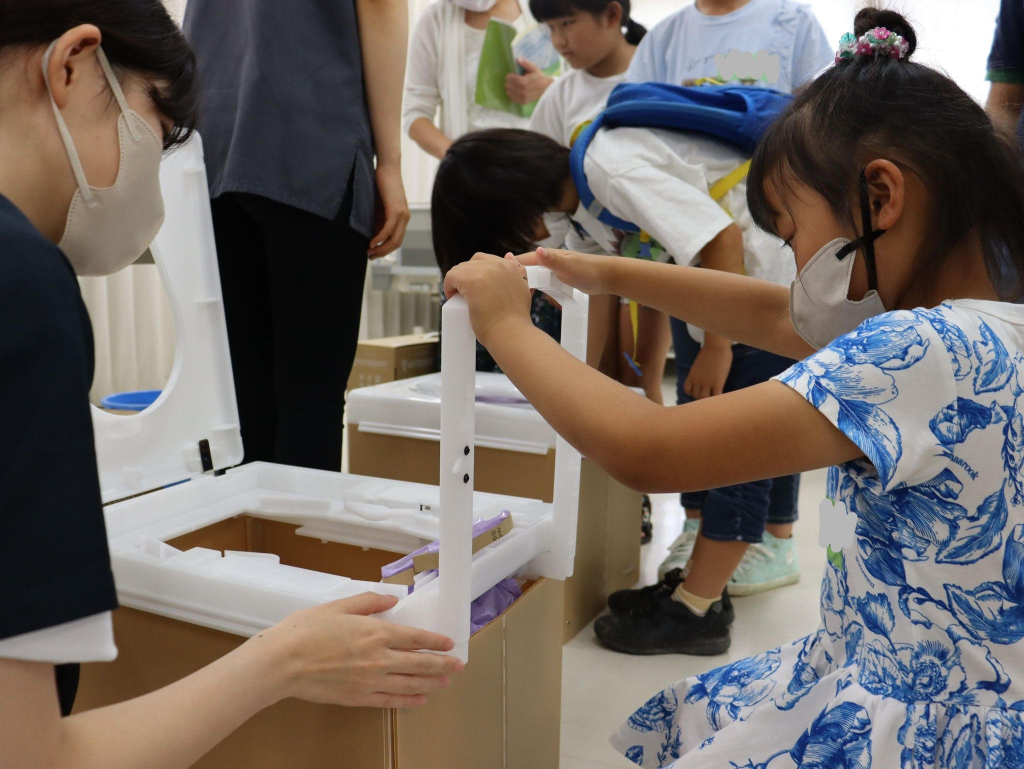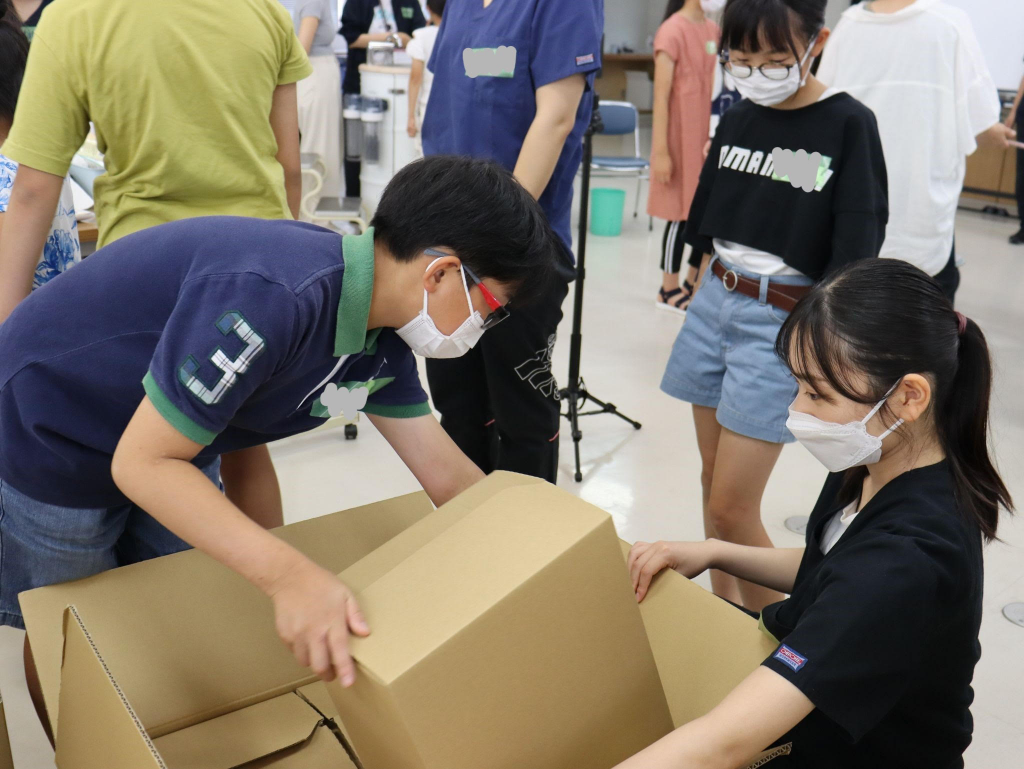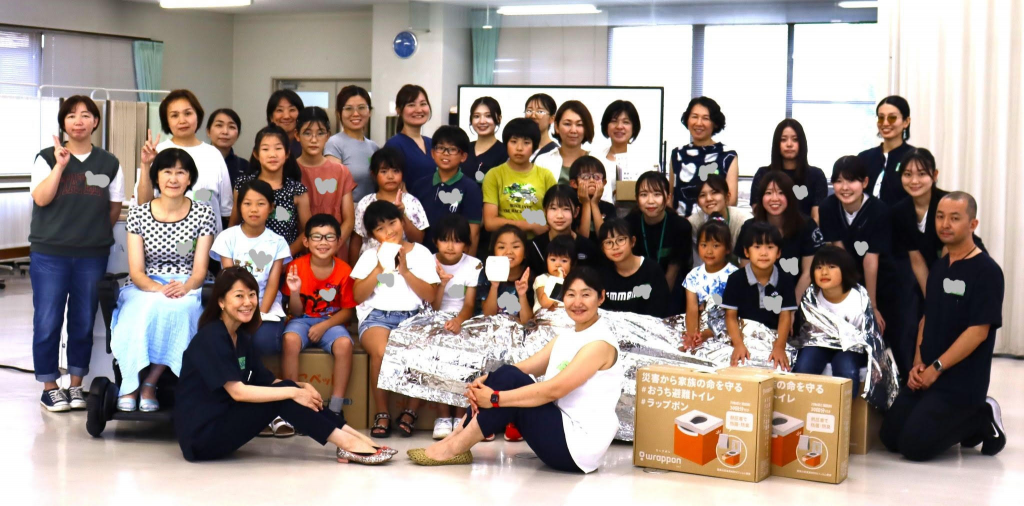教授の原田の研究室配置の4年生5人、3年生1人、ヘルスシステム統合科学研究科保健学研究科博士課程院生2人、県立看護大学保健福祉学研究科修士課程院生2人、医療教育センターの山下さん、車いすユーザーの石山さんの協力を得て、赤磐市の小学生世帯と災害に備えて今できることをできるようになるワークショップを開催しました。
ももの国子どもDRRワークショップでの体験と学び
7月16日、奇しくも前日に秋田県で豪雨災害があったこの日、岡山大学にて、赤磐市の学習塾の生徒16名とその保護者をゲストに迎え、ももの国子どもDRRワークショップが開催されました。このワークショップでは、講師として塾長の堤敬子先生、管理栄養士の濱田真理先生、岡山大学教授原田奈穂子先生、そしてゲストスピーカーに車椅子ユーザーの石山絢央衣さんを迎え、災害発生時の行動や防災について学びました。 内容は大きく「にげるセッション」「つながるセッション」「やってみるセッション」「たべるセッション」の4つが行われました。 「にげるセッション」では子供たちが住んでいる地域のハザードマップが渡され、どのルートを通れば安全に非難ができるか子供たち自身で考えました。どの避難所に行くにも危険な道を通らなくてはならず、困っていた子供がいましたが、講師からの助言を受け、状況が酷くなる前に早めに非難することの重要性を学ぶことができていました。「つながるセッション」では、親と別々に避難することになった場合、子どもたちが使える連絡手段について考えました。自分の携帯電話が使えなくなった時、周りの大人に助けを求めたり携帯ゲーム機の通信機能を使うなど、子供たちが持っている物を活用した手段を考えられていました。「やってみるセッション」では、浄水システムWOTA、段ボールベッド、携帯トイレラップポン、アルミブランケットを実際に体験してみました。 今回私は、学生スタッフとしてラップポンの使い方を説明、実践しました。災害時下水が使えなくなった場合、凝固剤を使用してトイレの抗菌・消臭を行い感染症を予防すること、排泄物を手を汚さずに密閉し処理できることを説明すると、子どもたちはその仕組みに興味津々で、また、実際に使用してみて普段使用しているトイレとの違いや簡易トイレを準備しておくことの必要性を感じていました。「たべるセッション」では、濱田先生監修の下、火を使わずに美味しくかつ備蓄できる防災食がふるまわれました。混ぜご飯にチキンライス、おかずが2品とデザートまでついており防災食とは思えないクオリティでした。実際に食べてみましたが、普段の食卓で出されても美味しく食べられる食べ物ばかりでした。 最後にゲストスピーカーの石山さんから、障がいがある人の避難の難しさについてお話がありました。石山さんは参加している子供たちに、避難する際に障がいがある人にとっては支援が必要なことを伝えると同時に、「できないことはしなくてもいい、できないことは周りの大人に助けを求めてください。」とお話しされました。この時私は、災害が起こった時、人々がお互いに支えあうことが必要になると同時に、将来医療職者として働く者として助けを求められたときに助けることができる大人でなければならないと強く思いました。誰もが混乱する災害で、子どもたちや障がいがある人、地域の人々が支援を求めている時に、知識や技術を持つ者として助ける側に回れるようになりたい、安心を与えられる大人でありたいと思いました。そのためにも、災害発生時自分の身をまず守れるように、避難行動や防災グッズを備え準備を怠らないことがまず重要であると、ワークショップの参加を通じて改めて学ぶことができました。
文責:磯部朱里




注:写真掲載には参加者のみなさんの同意を得ています
Note: Consent for publication of the photos was obtained from all participants.
On July 16, amidst the heavy rainfall disaster in Akita Prefecture the day before, the Momono-Kuni Children’s Disaster Risk Reduction (DRR) Workshop took place at Okayama University. The workshop aimed to prepare elementary school students and their households in Akaiwa City for potential disasters and equip them with knowledge and skills to respond effectively. The event was organized with the collaboration of five fourth-year students, one third-year student from Professor Harada’s laboratory, two doctoral students from the Graduate School of Health Sciences and Health Systems Integration, Okayama University, two master’s students from the Graduate School of Health and Welfare Sciences, Prefectural University of Nursing, Mr. Yamashita from the Medical Education Center, and Mr. Ishiyama, a wheelchair user.
Experiences and Lessons from the Momono-Kuni Children’s DRR Workshop
The workshop welcomed 16 students from a local learning center in Akaiwa City and their parents as guests. It featured four main sessions: “Escape Session,” “Connect Session,” “Try Session,” and “Eat Session,” during which participants learned about disaster response and preparedness. The workshop was led by the head of the learning center, Keiko Tsutsumi, registered dietitian Mari Hamada, Professor Naho Harada from Okayama University, and guest speaker Ayoi Ishiyama, who shared insights as a wheelchair user.
In the “Escape Session,” the children were given hazard maps of their neighborhoods and had to figure out safe evacuation routes independently. Some children encountered challenges in finding safe paths to evacuation centers, but with guidance from the instructors, they learned the importance of evacuating early before the situation worsened. During the “Connect Session,” the children discussed communication methods in case they were separated from their parents during evacuation. They explored using communication tools like asking nearby adults for help or utilizing the communication features of their gaming devices.
In the “Try Session,” the participants had hands-on experiences with disaster preparedness tools such as the WOTA water purification system, cardboard beds, portable toilet wraps (lappons), and aluminum blankets. As a student staff member, I explained and demonstrated the usage of lappons. The children showed great interest in understanding how to use these items effectively to prevent infections and maintain hygiene when regular water and sanitation facilities are unavailable.
In the “Eat Session,” supervised by Ms. Hamada, the participants were served disaster-resistant meals that were delicious and easy to store without using fire. The menu included mixed rice, chicken rice, two side dishes, and dessert, all of high quality and taste. The children were impressed that such meals could be enjoyed even during ordinary times.
Lastly, guest speaker Ayoi Ishiyama shared her insights about the challenges faced by people with disabilities during evacuations. She conveyed the importance of support for individuals with disabilities during emergencies and emphasized that seeking help from others is okay. This reminded me that in times of disaster, as future healthcare professionals, we must strive to be capable and compassionate adults who can support those seeking assistance. I realized that being prepared to protect oneself during disasters and possessing knowledge of evacuation procedures and disaster supplies are vital in fulfilling this role. Through this workshop, I reaffirmed my commitment to becoming a capable adult who can offer reassurance and assistance to children, individuals with disabilities, and community members seeking support during chaotic times of disaster.
Contact: Akari Isobe
